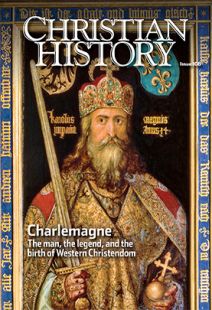Charlemagne, Did you know?
Charles, Louis, Charles, Louis. . .
In a world without last names, famous people were known by their nicknames. Charlemagne, originally called Charles or Karl, became “Charles the Great”: “Carolus Magnus“ in Latin and “Charles le Magne” in Old French. His father was called Pepin (or Pippin) the Short, and his mother, Bertrada, “Bigfoot Bertha.” Presumably she was tall—or at least taller than Pepin!
One of Charlemagne’s illegitimate sons was “Pippin the Hunchback,” his legitimate son Louis (who later inherited the empire) was “Louis the Pious” due to his reputation for devoutness, and one of Louis’s brothers was “Charles the Younger.” Charlemagne’s grandchildren fared worse: “Charles the Bald,” “Louis the Stammerer,” “Charles the Child,” and “Lothar the Lame” were among them. The empire finally collapsed under Charlemagne’s great-grandson “Charles the Fat.”
Catching mice
Charlemagne encouraged scholarship in monasteries throughout his empire. While monks preserved and copied manuscripts, they sometimes voiced complaints and thoughts in the margins: the heat, the cold, the fact that their pens didn’t work, the disruption of nearby battles, and even the singing of birds outside the windows.
One Irish monk wrote a whole poem about his cat on a copy of Paul’s epistles. It reads in part: “I and Pangur Bán, my cat / ’Tis a like task we are at; / Hunting mice is his delight / Hunting words I sit all night. . . . Practice every day has made / Pangur perfect in his trade; / I get wisdom day and night / Turning darkness into light” (translated by Robin Flower).
Lunch in the Early Middle Ages. . .
. . . would have been bread, certainly; meat, probably (although if you were a peasant, maybe not); and ale, without a doubt. It would have been seasoned with many herbs but few spices and cooked over a large open fire in the middle of your house.
You would have eaten it from wooden plates, mostly with your hands, and finished up the meal with a generous helping of fruit. (Read more about what people of Charlemagne’s day ate, wore, and did in “How they feasted and fasted,” pp. 34–35).
I want an elephant for Christmas
In 797 Charlemagne sent ambassadors to the ruler of the Arab world, Harun al-Rashid (“Harun the Upright”), whose magnificent court at Baghdad was later memorialized in the tales of the Thousand and One Nights.
Charlemagne’s delegation included two envoys and a Jewish interpreter named Isaac. Imagine everyone’s surprise when Isaac returned five years later (the envoys, Lantifrid and Sigimund, had died en route) with a present from the caliph for Charlemagne—an elephant.
No one had seen an elephant in Europe for a thousand years, and they were the stuff of legend; it was as if someone today brought a unicorn to the president. The elephant caused a great sensation in Aachen, Charlemagne’s capital, and became a tourist magnet. Called Abbu’l Abbas, it may have died in 810 on a war campaign near the Rhine. Harun’s own annals do not mention the gift; Charlemagne’s small and far-away kingdom was of little note to the famed Arab caliph.
Meet my joyful sword
Swords were serious business in the Middle Ages, and blacksmiths highly honored. Made from iron and carbon, a good sword could cost as much as three cows. Knights and rulers often named their swords. Charlemagne called his Joyeuse, “joyful.” Many swords spawned whole legends. English king Edward the Confessor (reigned 1042–1066) supposedly wielded Sword of Mercy, and King Arthur’s Excalibur even gave its name to a movie about the mythical ruler.
Todaywedon'twritelikethis. . .
. . . because of advances in handwriting made in Charlemagne’s court. At the palace school he encouraged (see “For the love of learning,” pp. 24–29), students were taught a new style of writing later called “Carolingian minuscule.” Spaces between words and lowercase letters became common—neither had been used before.
Handwriting was not the only thing taught at the school. Charlemagne and his advisors were very interested in the study of the Old Testament, and many took biblical names that they used in their correspondence with each other and in writing poetry. Charlemagne, naturally, was King David.
Are we there yet, Daddy?
Charlemagne had 17 children that we know of, both legitimate and illegitimate, and was married either four or five times (historians differ as to whether his first long-term partner was a wife or concubine). He liked to take his whole family with him on his travels and his sons on military campaigns. Travels were frequent until Charlemagne established a permanent capital for his empire at Aachen in the 790s.
Charlemagne refused to let any of his daughters marry, not wanting them to become political pawns, but he did not frown on affairs. One daughter, Bertrade (779–826), had a long-term relationship with one of Charlemagne’s courtiers, Angilbert. Their son Nithard became a notable historian. Another, Rotrude (775–810), was betrothed as a child to Byzantine emperor Constantine VI. She never married him, nor her later lover the Count of Maine, and ended up as a nun in a convent where Charlemagne’s sister Gisela was the abbess. CH
By the Editors
[Christian History originally published this article in Christian History Issue #108 in 2014]
Next articles
The Dark Ages? Think again
Charlemagne’s kingdom arose out of the scattered pieces of the declining Roman Empire, but also out of a vibrant Christian culture.
Edwin Woodruff TaitThe man behind the empire
Charlemagne was a paradox: a warrior who fostered scholarship, a man capable of ruthless rule and devout piety
G. R. EvansCharlemagne vs. the Saxons
Were the Saxon wars really driven by the desire to convert these pagans?
G. R. EvansSupport us
Christian History Institute (CHI) is a non-profit Pennsylvania corporation founded in 1982. Your donations support the continuation of this ministry
Donate



